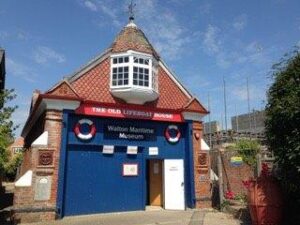Walton Maritime Museum
Essex Heritage Trust awarded a grant to the newly listed Grade II, Old Lifeboat House, now Walton’s Maritime Museum, for the conservation of its commemorative marble plaque and terracotta roundels. Badly eroded by frost damage, severe coastal winds and some physical damage, the 1884 commemorations were in poor condition and increasingly illegible.
Experienced conservator George Monger drove down every day to Walton from his Stowmarket base to carry out the specialist treatment with materials prepared in his workshop. Widely acknowledged for his skill, George was recommended by several historic buildings surveyors before being appointed by the Frinton and Walton Heritage Trust.
According to records in the Frinton & Walton Heritage Trust archive
‘when the plaque was installed it was black- faced marble and the lettering was in gold with the Honourable ArtilleryCompany’s coat of arms raised in white’. ‘At some time in the 1920’s the tablet was removed for renovation and when it was returned the base was black slate colour showing white veins and the lettering was in red.’
The marble plaque commemorates the handover of the first Walton Lifeboat and its Lifeboat House, by their funders, The Dramatic Club of the Honourable Artillery Company, recording the names of the different parties present.
The plaque is composed of a marble slab inscribed with text and headed by the Honourable Artillery Company’s coat of arms cut in stone and inset into the marble. The coat of arms detail is badly eroded with all colouring lost. The approach was not to attempt restoration but to hold back further erosion.
The whole plaque was washed down with a non-ionic detergent solution and brushed to remove lichen. The inscribed letters had lost their precise edge and shape, all compromised by the differential weathering of the marble’s face. Harsh colouring would have drawn attention to its deterioration. It was resolved to coat the marble to stabilise the surface and so avoid any ‘bleeding’ of colour.
The letters were cleaned out using a wooden probe. They were not painted, but their clarity heightened by using ‘rotten stone’ powder to slightly darken the lettering. The marble was too eroded to polish – the inscriptions would have been lost – it was decided to apply a clear glaze to protect against further erosion in a three-coat cover.
The roundels’ conservation presented a very different challenge from the plaque. The terracotta roundels had glaze erosion, a severe crack and damage to the decorative details of the lifeboat form and the banners bearing the RNLI name and 1884 date recording the set-up of the Walton Lifeboat Station. After cleaning and removal of old filling, repair and carefully blended colour, both roundels are now splendidly restored complete with protective coatings.

